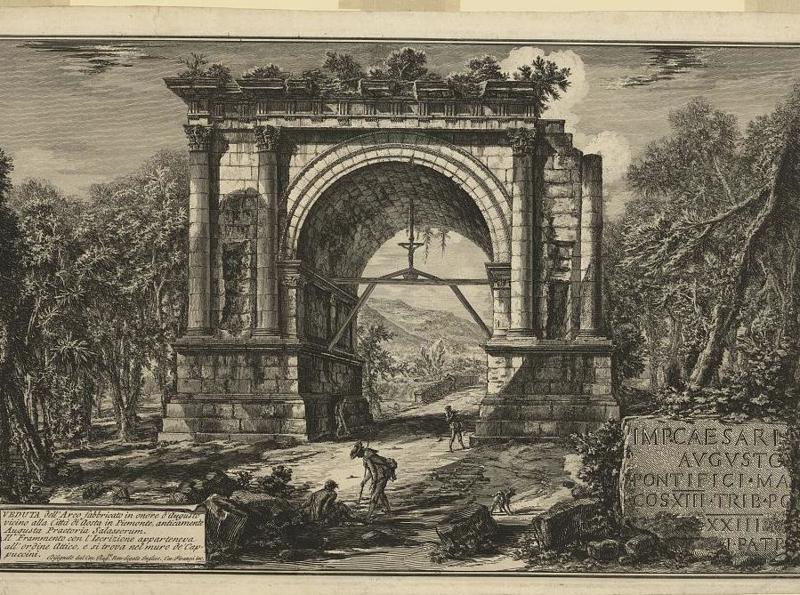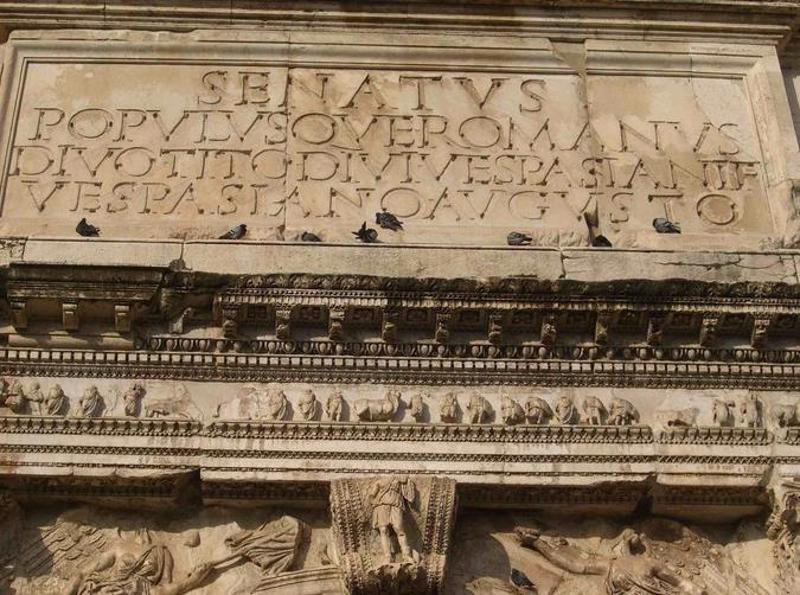Notable Sites from Rome’s Golden Age
Next I visited the Arch of Augustus, part of the beautiful Roman imperial architecture (see image 8). The arch was built in Rimini 27 B.C.E. and stands as the entrance linking Rome and Rimini. The arch was constructed to celebrate all of the great Augustus’ hard work in restoring the city of Rimini and the Via Flaminia and in developing many successful initiatives for the city.
The commemorative arch is constructed of marble and Istrian stone. It has a single arch with one barrel-vaulted entryway that measures 8.84 meters with a height of 10.4 meters and a depth of 4.10 meters. The arch lies on two columns that have Corinthian capitals and fluted stems. On both sides, two ox heads can be seen- which I was told by a local, was to symbolically represent the city of Remini being acknowledged as a colony of Rome. The arch is decorated with various symbols and four clipei (shield) that represent the gods Jupiter and Neptune, Apollo and Minerva. Additionally, this triumphal arch has an inscription at its top (see image 9) which reads:
“SENATUS
POPULUSQUE ROMANUS
DIVO TITO DIVI VESPASIANI F[ILIO]
VESPASIANO AUGUSTO”
Or, “The Senate and People of Rome [dedicate this] to the Divine Titus Vespasian Augustus son of the divine Vespasian.”
I also learned that the arch’s dimensions were intentionally made to make it impossible to build a door as requested by Augustus who
mn2904
4 chapters
6 Dec 2020
Arch of Augustus (Arco di Augusto)
December 14, 2020
Next I visited the Arch of Augustus, part of the beautiful Roman imperial architecture (see image 8). The arch was built in Rimini 27 B.C.E. and stands as the entrance linking Rome and Rimini. The arch was constructed to celebrate all of the great Augustus’ hard work in restoring the city of Rimini and the Via Flaminia and in developing many successful initiatives for the city.
The commemorative arch is constructed of marble and Istrian stone. It has a single arch with one barrel-vaulted entryway that measures 8.84 meters with a height of 10.4 meters and a depth of 4.10 meters. The arch lies on two columns that have Corinthian capitals and fluted stems. On both sides, two ox heads can be seen- which I was told by a local, was to symbolically represent the city of Remini being acknowledged as a colony of Rome. The arch is decorated with various symbols and four clipei (shield) that represent the gods Jupiter and Neptune, Apollo and Minerva. Additionally, this triumphal arch has an inscription at its top (see image 9) which reads:
“SENATUS
POPULUSQUE ROMANUS
DIVO TITO DIVI VESPASIANI F[ILIO]
VESPASIANO AUGUSTO”
Or, “The Senate and People of Rome [dedicate this] to the Divine Titus Vespasian Augustus son of the divine Vespasian.”
I also learned that the arch’s dimensions were intentionally made to make it impossible to build a door as requested by Augustus who


strived to maintain peace among the territories during the Pax Augusta. Thus, the arch holds great symbolic meaning in addition to social-political connotation.
Image 8: A photo showing the front of the Arch
https://www.loc.gov/item/97511265
Image 9: The inscription written on the arch
http://omeka.wellesley.edu/piranesi-rome/exhibits/show/arch-for-titus/inscription
* Sources:
http://projects.leadr.msu.edu/medievalart/exhibits/show/triumphal_arches_of_rome/arch-of-augustus
https://doi.org/10.2307/500028
http://archive1.village.virginia.edu/spw4s/RomanForum/GoogleEarth/AK_GE/AK_HTML/MA-001.html
Share your travel adventures like this!
Create your own travel blog in one step
Share with friends and family to follow your journey
Easy set up, no technical knowledge needed and unlimited storage!